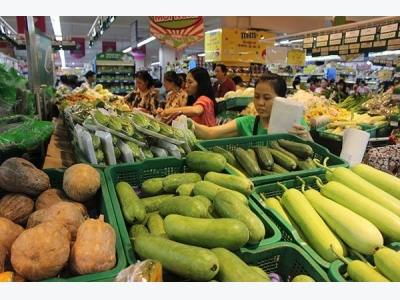China makes up three-fourths of Vietnams vegetable, fruit exports

Shoppers buy vegetables at a Co.opmart supermarket in HCMC. China spent US$2.17 billion importing vegetables and fruits from Vietnam in the first ten months of 2017 - PHOTO: TL
Ho Chi Minh City - China spent US$2.17 billion importing vegetables and fruits from Vietnam in the first ten months of 2017, making up nearly 75.9% of Vietnam’s total export revenue from these products, according to the General Department of Vietnam Customs.
Vietnam exported US$240 million of vegetables and fruits last month, taking the total to US$2.86 billion in the year to end-October, up 42.6% year-on-year.
Revenue from vegetable and fruit exports exceeded that of Vietnam’s key export products such as rice, crude oil and coal.
Analysts said the target for some US$3 billion from vegetable and fruit exports this year is achievable. However, they expressed concern over the Vietnamese vegetable and fruit export sector’s increasing dependence on China.
A huge volume of vegetables and fruits has been shipped to the neighboring country, which is an easy but risky market for Vietnam. China accounted for around 30% of Vietnam’s vegetable and fruit exports in 2014 and the percentage rose to 70% last year and nearly 76% in the first ten months of this year.
Vietnam also reported higher vegetable and fruit exports to choosy markets such as Japan and the U.S. in January-October. Particularly, Japan purchased US$104 million of vegetables and fruits from Vietnam while the U.S. imported US$84 million of the products from Vietnam, growing 67.6% and 23.2% against the year-ago period respectively.
The UK, South Korea, the Netherlands, the United Arab Emirates and Malaysia bought a large volume of vegetables and fruits from Vietnam in the period.
In a related development, Vietnam spent US$120 million importing vegetables and fruits in October, raising the total in the first 10 months to nearly US$1.3 billion, surging 92.7% year-on-year.
Thus, Vietnam had a trade deficit of nearly US$1.6 billion in this sector.
Secretary of the HCMC Party Committee Nguyen Thien Nhan early this month proposed listing fruits and other farm produce as key export items of Vietnam and issuing preferential policy to step up exports of such products.
Last year, Vietnam exported US$2.4 billion of crude oil, US$2.15 billion of rice, US$3.3 billion of coffee, US$7 billion of seafood and US$2.45 billion of vegetables and fruits. For the first time, the export value of vegetables and fruits was higher than that of crude oil, Nhan noted.
In 2005, export revenue from crude oil was US$7.3 billion, 31 times higher than that of vegetables and fruits (US$235 million).
Export turnover from vegetables and fruits is expected to reach US$10 billion by 2020.
Minister of Industry and Trade Tran Tuan Anh said Vietnamese vegetables and fruits have been easily exported to other countries. Vietnam has achieved impressive results in the process of finding new markets for these products despite technical barriers.
Vietnam has shipped dragon fruit, rambutan, longan and litchi to the U.S., litchi and mango to Australia, mango and dragon fruit to Japan, South Korea and New Zealand, and fresh fruits to ASEAN, the European Union, the Middle East, Eastern Europe and Canada.
The ministry is negotiating to help export shrimp to Australia, pork to China, the Philippines and Singapore, processed chicken to Japan, salted eggs to Hong Kong and Singapore, mango and star apple to the U.S., mangosteen, grape fruit and custard apple to China, and longan, litchi and rambutan to South Korea and Japan.
Có thể bạn quan tâm
 Turkey, poultry wastes could replace coal
Turkey, poultry wastes could replace coal While turkeys at Thanksgiving are an age-old custom, a new study shows that turkey excrement may have a future as a fuel for heat and electricity.
 Workshop discusses Belgian support for Vietnam’s agriculture
Workshop discusses Belgian support for Vietnam’s agriculture The workshop looked into engagement between the two countries’ governments, universities, institutions, and businesses
 PM approves agricultural restructuring plan in 2017-2020
PM approves agricultural restructuring plan in 2017-2020 The plan also calls for more applications of science and technology in the sector to create high-quality varieties, adopting intensive farming